Big Time: Introduction
"I don't know what the Big Time is. It's relative to who you are and how far you've come...the big time is whatever you think it is: everything from 40 acres and a mule to owning Belgium, or having a pack of cigarettes and a place to get out of the rain."
It all started with a simple song from Swordfishtrombones (1983) called "Frank's Wild Years". Frank burned his house down (Carlos the little Chihuahua that had some kind of skin disease and was totally blind, might not have survived) and he got on the Hollywood Freeway and headed North. That could have been it. Just another funny song. But somehow Waits couldn't let go. He further developed the character of Frank and wrote an entire play telling the continuing story of Frank dreaming his way into show business. After the play, Waits even released an album with studio versions of the songs from the play (Franks Wild Years, 1987). The play, starring Waits as Frank O'Brien, premiered June 17, 1986 (Steppenwolf Theatre company, Chicago's Briar Street Theatre). It ran for 2 months and received "mixed reviews".
"Frank O'Brien: What can you say about Frank that hasn't already been written? Quite a guy. Grew up in a bird's eye frozen, oven-ready, rural American town where Bing, Bob, Dean, Wayne & Jerry are considered major constellations. Frank, mistakenly, thinks he can stuff himself into their shorts and present himself to an adoring world. He is a combination of Will Rogers and Mark Twain, playing accordian -- but without the wisdom they possessed. (He'll get his). He has a poet's heart and a boy's sense of wonder with the world. A legend in Rainville since he burned his house down and took off for the Big Time."(3)
Tom Waits (1987): ''I just didn't have the time to do the work that the play would have needed... We would have had to have taken it someplace else first before New York, and the chain just seemed too long and involved. ''But doing the play was a great experience for Kathleen and myself... It was great, living in Chicago. I miss it."(4)
But still, after the song, after the play and after the album Waits couldn't let go of Frank O'Brien. He went on tour (October 1987 - December 1987: Michael Blair, Ralph Carney, Greg Cohen, Marc Ribot, Willy Schwarz) promoting the album. And on stage Waits played Frank O'Brien again.
The tour (regarded by many as his best tour ever) went from Canada to the USA to Europe. Halfway through the tour the Fox Warfield and Wiltern Theatre shows were filmed, before leaving for Europe. This footage was going to be turned into a concertfilm, to be released in 1988 as Big Time.(2)
 |
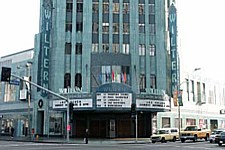 |
|
Warfield Theatre (aka Fox Warfield)
982 Market St., San Francisco |
Wiltern Theatre
3790 Wilshire Blvd., Los Angeles |
It's remarkable to see how long Waits hung on to his alter ego Frank O'Brien. Starting in 1983 (Swordfishtrombones) and ending in 1988 (Big Time). It's obvious that Waits went through some kind of transformation with the "Swordfishtrombones - Rain Dogs - Franks Wild Years" trilogy. And maybe he was letting Frank do the job for him, or maybe posing as Frank on stage made it easier to go through it all. Maybe Frank's story had to be finished and documented before Waits could go on. Notice that on later albums (Night On Earth, Bone Machine, The Black Rider) there's nothing to be found like Frank or his story. In retrospect, Big Time is Waits saying goodbye to Frank and Frank's dreams of show business success.
The idea of a concertfilm arose when recording the album Franks Wild Years. Waits first mentioned the upcoming project in an interview with the Los Angeles Times, calling it "Crooked Time" (January, 1988).(7) The elaborate stage set of the tour would have to be adapted for the film. It's obvious that the thematic and pictorial elements of Big Time have as their inspiration the stage and album versions of Franks Wild Years. The plots of both works hinge on small-town dreams of show business success. Waits even gave the album Big Time the same sub-title ("Un Operachi Romantico").
Tom Waits (1988): "Kathleen was the only one who really pushed to have a film done. I'd get home from the road, and I wouldn't have any pictures of the band or anything. We'd talk about it like something that didn't really happen. It was the first that we pursued pulling it together."(1)
Tom Waits (1988): "I've been threatening it for a long time and eh my wife finally said: "Well, I guess it's time we get something here that we can look at after you come back from the road." Cause you rarely come home with anything that eh... Yeah you get some snapshots and some reviews but... I guess it gives me a chance to ehm... eh capsulise eh some of the songs on the last 3 albums and eh... y'know?"(8)
"Chris Blum, Waits' friend and collaborator, was selected to direct the feature. His work with Waits included (video-) spots for Franks Wild Years, a music video for the song "Blow Wind Blow" from the latter album, and a 12-minute interview piece prepared for European television. Blum also served as the scenic designer for the Chicago stage production of Franks Wild Years. Blum became involved with the production of Big Time early in the project's development. Like Blum, four of the five musicians in Waits' 1987 touring band were old associates, who had performed with the singer on his 1985 Rain Dogs tour. Bassist Greg Cohen had played with Waits for the last nine years; he was the musical director on Steppenwolf's production of Franks Wild Years, Saxophonist Ralph Carney, who had also appeared on Waits' last two albums, was formerly a member of two seminal Midwestern new wave bands - Cleveland's Tim Huey and Akron's The Waitresses - and had also recorded with the B-52's, in addition to leading his own New York based groups. Guitarist Marc Ribot (of the New York punk-jazz band the Lounge Lizards) and drummer Michael Blair (featured percussionist on the '85 tour) also played on Rain Dogs and the Franks Wild Years LP. The sole newcomer to the tour band was accordionist Willy Schwarz, a Chicago based musician."(1)
Chris Blum (1988): "The original stage set started out as a junkyard. We had an idea for these huge plexiglass signs, like the ones you see in L.A.'s Koreatown - back lit, primary colored." (Eventually Waits and lighting designer Darryl Palagi simplified the concept to the light boxes seen in the film) "We designed everything else around the light boxes - it's like having an elephant In the middle of the room. Each band member in the film was assigned one. Even though they're supplemented by other sources, we wanted to give the impression that they were the only light sources. Then we developed the red-and-black checked floor. The attempt was always to have things look non-art-directed. It took on a Count Basie-art-deco-Copacabana kind of look, in the end."(1)
Tom Waits (1988): "You want a concert film to have something other than just concert footage, but at the same time, it is that kind of animal. So Chris weaves in a subplot about a guy working in a theatre - the usher, the ticket taker, the fella in the booth - who falls asleep and dreams about show business."(1)
Tom Waits (1988): "It's never done as a linear piece of fiction. It was just a way to try and create some kind of other dimension and stability. Concert film is a bit of an orphan because you're filming something that happened live. There are inherent problems with it. Even when it's great you think. It's great, but shouldn't we have been there? Is that all you want me to feel - that I missed it, that it happened and I wasn't there? ... I told Chris. "Film it as if you were at a Mondo Cane voodoo ceremony - if you get caught, you get killed." because I didn't want cameras on the stage. This excited him. We did it in only two nights of concerts - six cameras the first and two the next. If we had had more money, we could have done the scene with the Chinese ladies, the midgets, and the Portuguese horses."(10)
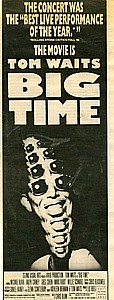
Los Angeles Times advert promoting one week screening of Big Time (premiere), starting
September 30, 1988.
Thanks to Dorene LaLonde for donating scan.
Click picture for larger version
Big Time premiered at Healdsburg's Raven Theater September 1988, which Blum co-owned at the time. A couple of months later it was released as a commercial VHS video tape with its accompanying album.
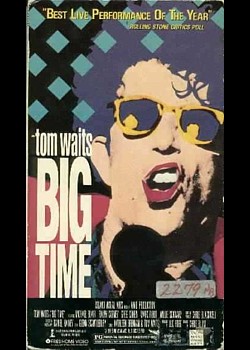 |
 |
|
Big Time VHS, 1988
Fries Home Video (Fries Entertainment Inc.) |
Big Time VHS, 1988
PolyGram Video (Island Visual Arts) |
Tom Waits (1988): "What we tried to avoid is having a concert film that felt like a stuffed bird. I tried to film it like a Mexican cockfight instead of air-conditioned concert footage. Some of it felt like it was shot through a safari rifle. You forget about the camera, which is what I was trying to do. But when you see yourself in concert, it rarely looks like the way you feel when you're up there. I thought I was much taller. I thought I looked like Robert Wagner ... if we had more money, we would have done the Rangoon gladiator sequences. And the shot of the audience holding up their matches and all that. We could have gotten the underwater ballet sequences, but it really would have been a different film, I think ... Now that it's completed, I would not have had my underwear coming out of the back of my pants like I did, but there's always something you want to change after it's over."(5)
Tom Waits (1988): "The idea was, you put the film out there, the film can go on the road, and I can stay home. That was the idea, but then I end up having to go out and do interviews. [Big Time is] getting mixed reviews. I guess that's what they call it - mixed reviews. One reviewer said, 'Piano teachers will be shocked,' which is one of my favourite reviews. Another guy said it looked like it was filmed in the stomach of a very sick animal. Now those were the good reviews. I recommend it."(6)
Tom Waits (1989): "We tried to give it a little bit of that infrared Mondo Cane feel so that it didn't look like a stuffed bird. There's no cameras on stage, there were six cameras up in the balcony. So we got that safari rifle feel. It's difficult, because there're just so many ways to skin a cat. We laid an egg, so we're waitin' for it to hatch now. Most concert films are orphans, I guess, 'cause they're like docu, uh, docu, uh... docu-orchestra. It pales next to being there, in most cases, and it's hard to get just the right vantage point. In this case, it was sitting right on my moustache."(11)

Promo picture from the "Big Time press kit" , 1988. Photography: Daniel Hainey
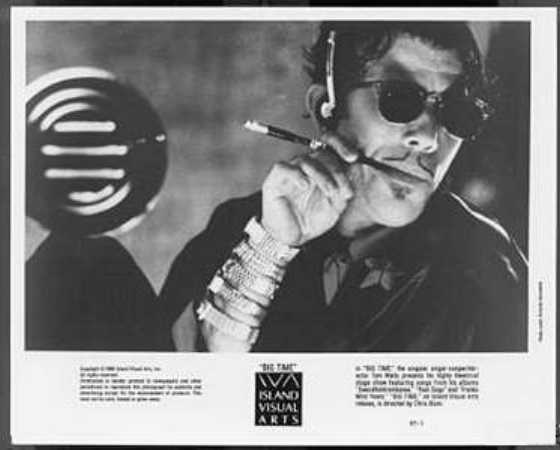
Promo picture from the "Big Time press kit" , 1988. Photography: Daniel Hainey
The footage for Big Time was shot at both the Warfield Theatre/ San Francisco (November 5-6, 1987) and the Wiltern Theatre/ Los Angeles (November 7-9, 1987). The in between shots of Frank in a ticket booth and Frank aiming a spotlight, are from the Warfield theatre. It's certain that Big Time has footage from November 5 and November 9. It's not exactly clear from which show(s) the other footage is.
When comparing the film with (audience) recordings from the original shows, it turns out that Waits's voice has been considerably lowered, apparently wanting to give more power to the songs. And during post production, the film makers added several audio effects (stamping of boots, finger snapping, maracas, gunshots, train whistles. traffic noise, laughter, applause, etc). There is also footage added that doesn't seem to be recorded before a live audience ("9th and Hennepin" and "Innocent When You Dream"). The strangest alterations however concern the order of the songs and their intros. The original order has been completely changed and intros have been cut off or switched. It's hard to figure out why these changes have been made, but it most likely has to do with the availability of good footage. The film has been divided in 3 acts, but there seems to be no logic behind this. It might be the division in acts was just introduced to give the film a bit of an opera feel.
It's tempting to see Big Time as another go at the stage version of Frank Wild Years. And to a certain degree it is. Notice the introduction of "Franks Wild Years" (when Frank wakes up and goes to sleep again on New Years Eve): "Well this is a story about a guy named Frank O'Brien." And the outro: "And so Frank followed the Hollywood Freeway to pursue his lifelong dream of working in the entertainment industry." Just like the stage version of Franks Wild Years, we're witnessing Frank's dreams. We're seeing Frank himself in his silk pajamas (as an usher and a ticket taker), and we're seeing the strange and beautiful characters he meets on the way (a wisecracking pianist, a white-jacketed lounge entertainer, a crazy preacher). And the dream logic of the film has us wondering: is it Frank, is it Frank dreaming he's Waits, is it Waits himself, or is it Waits dreaming he's Frank?
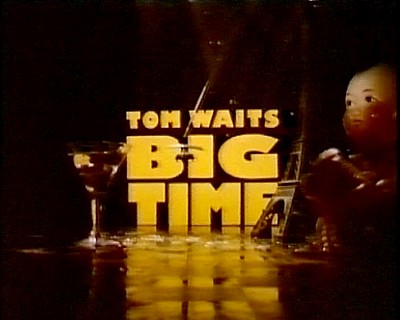
Big Time opening sequence (Big Time screenshot)
Tom Waits (1988): "A lot of people are comparing it to Zulu, The Pawnbroker, Mondo Cane, Ghandi, ehm... A lot of the larger gladiator-sequences were cut out and eh... it gave me a chance to work with Faye Dunaway. Which was always a big dream of mine."(8)
Chris Blum (2008): "I still really like him going to sleep and pounding on the pillow and the pillow explodes and feathers fly in the air and then I cut to him on the stage and feathers fly down on top of him and he takes of his hat and catches a few pillow feathers in his hat."(13)
Tom Waits (1988): "All the scenes with Faye Dunaway were cut out. But it's, you know... All the cruise ship sequences are intact, tribute to Frank Sinatra in New York is in there."(9)
Chris Blum (2008): "The film is predominately red and black. I don't know if you know this or not, but Tom is color blind. The only colors he really can see are red and yellow. And so a lot of the visuals that revolve around Tom's work are red or yellow." Q: Did you guys talk about that when you were filming the movie? A: No, I didn't find out that Tom was color blind until years later."(13)
Tom Waits (1988): "It's Swabbie night at the Copa shot through the lens of an African safari rifle. Basically it's an action film."(10)
Chris Blum (2008): "It's the first ever electronically edited film. We edited on a Montage machine down in San Francisco at One Pass. It made it much easier to sift through more than 30 hours of footage. The editor was Glen Scantlebury, whose last film was "Transformers."(13)
Tom Waits (1989): "It's a retirement concert. I'm going into the shoe business and I just wanted to say goodbye. Y'know. It's a home movie. I guess I wish I had some old black-and-white footage of myself now. From, y'know, "Hullabaloo." But now I don't have much at all. I lost a lot of the stuff in a fire. I had an ex-manager who ran off to Hong Kong, took all my press clippings."(11)
Chris Blum (2008): "There's not one motor vehicle, virtually no architecture or telling wardrobe. The film looks like it could've been made six months ago. There are no coordinates in there. Nothing to let you know it's old. It could've been made 20 years ago or 40 years ago or four months ago. I know I did that purposely. I didn't want to lock this thing into any given time or era. I wanted it to be timeless because Tom's work really is timeless. Just about anything he does could've been done in 1920 or in 2012."(13)
Not long after the film was made, the British company that produced it was bought by another company, who was later bought by another company. Today it's rumored to be wasting away in an MGM vault. Blum and Waits talked about finally releasing a DVD, toying with the idea of donating all the profits to charity, but there are no plans as of yet. Fortunately, Blum had the foresight to pay for his own personal print that he stores at The Rafael Film Center. "I take it out every few years," he says. "Get the dust off and run it through a projector before it's too late"(13)
The album Big Time, was released late 1988. It has the two previously unreleased songs: "Falling Down" (recorded in the studio with Richie Hayward, Larry Taylor and Fred Tackett) and "Strange Weather." The album also has several alternative versions of the songs from the film ("Big Black Mariah", "Telephone Call From Istanbul", "Clap Hands" and "Time"). In addition, there are also some songs on the album that do not appear in the film ("Red Shoes", "Underground", "Straight To The Top - Rhumba", "Yesterday Is Here", "Falling Down" and "Ruby's Arms"). According to the album liner notes, the songs were recorded live in Los Angeles, San Francisco, Dublin, Stockholm and Berlin.
To make things even more complicated, the film has songs that don't appear on the album ("Franks Wild Years", "Shore Leave", "Hang On St. Christopher", "Straight To The Top - Vegas", "9th And Hennepin", "I'll Take New York", "More Than Rain" and "Innocent When You Dream"). One is to fear there were commercial reasons behind the album and film not being identical.
| Album order | Movie order | Original order (Nov. 1987) |
| 1. 16 Shells From A 30.06 | 1. Just Another Sucker On The Vine (studio version, movie only) | 1. Hang On St. Christopher |
| 2. Red Shoes (album only) | 2. Franks Wild Years (movie only) | 2. 16 Shells From A 30.6 |
| 3. Underground (album only) | 3. Shore Leave (movie only) | 3. Down In The Hole |
| 4. Cold Cold Ground | 4. Way Down In The Hole | 4. Gun Street Girl |
| 5. Straight To The Top - Rhumba (album only) | 5. Hang On St. Christopher (movie only) | 5. Cold Cold Ground |
| 6. Yesterday Is Here (album only) | 6. Telephone Call From Istanbul (album and movie version not identical) | 6. Yesterday Is Here |
| 7. Way Down In The Hole | 7. Cold Cold Ground | 7. Telephone Call From Istanbul |
| 8. Falling Down (album only, studio recording. Previously unreleased) | 8. Straight To The Top - Vegas (movie only) | 8. Straight To The Top - Vegas |
| 9. Strange Weather (previously unreleased) | 9. Strange Weather (previously unreleased) | 9. I'll Take New York |
| 10. Big Black Mariah (album and movie version not identical) | 10. Gun Street Girl | 10. Train Song |
| 11. Rain Dogs | 11. 9th And Hennepin (movie only) | 11. Johnsburg, Illinois |
| 12. Train Song | 12. Clap Hands (album and movie version not identical) | 12. Frank's Wild Years |
| 13. Johnsburg, Illinois | 13. Time (album and movie version not identical) | 13. Innocent When You Dream |
| 14. Ruby's Arms (album only) | 14. Rain Dogs | 14. Underground |
| 15. Telephone Call From Istanbul (album and movie version not identical) | 15. Train Song | 15. Clap Hands |
| 16. Clap Hands (album and movie version not identical) | 16. 16 Shells From A 30.6 | 16. More Than Rain |
| 17. Gun Street Girl | 17. I'll Take New York (movie only) | 17. Strange Weather |
| 18. Time (album and movie version not identical) | 18. More Than Rain (movie only) | 18. Rain Dogs |
| 19. Johnsburg, Illinois | 19. 9th And Hennepin | |
| 20. Innocent When You Dream (movie only) | 20. Time | |
| 21. Big Black Mariah (album and movie version not identical) | 21. Big Black Mariah (band intro) | |
| 22. Shore Leave |
Notes:
(1) Source: "Big Time press kit". Island Records, September 1988. Read entire text: Big Time press Kit, 1988
(3) Source: "Franks Wild Years Theatre program", 1986
(4) Source: "Waits Measured: A Multifacted Singer Looks For New Directions" Chicago Tribune - Arts section (USA), by Lynn Van Matre. Transcription by Peter Dubsky. Date: October 18, 1987
(5) Source: "Tom Waits and His Act", Rolling Stone magazine, David Sheff. October, 1988
(6)Source: "Morning Becomes Eclectic" KCRW-FM, Schnobbel. October 3, 1988
(7) Source: "Tom Waits: Eccentric In The Very Best Sense". Los Angeles Times (USA). By Charles Champlin. Section: Calendar. Page: 6-1. Date: published January 14, 1988
(8) Source: "Fresh Air Interview" Fresh Air. NPR radio broadcast on WHYY. September 28, 1988. Terry Gross
(9) Source: "WNEW Radio interview". WNEW-FM, Mixed Bag. New York. October, 1988
(10) Source: "Tom's Wild Years" Interview magazine: Francis Thumm. Livingston/ Montana. October, 1988
(11) Source: "Neither Vinyl Nor Film Can Contain Waits" Film Threat magazine 18 (USA), by Steve Dollar. 1989
(12) Source: "Tom Waits" Graffiti Magazine (Volume 4, number 12). Tim Powis. December 1, 1988
(13) Source: "Rare Tom Waits Big Time Screening", Chris Blum interview. The Press Democrat. John Beck. April 16, 2008

